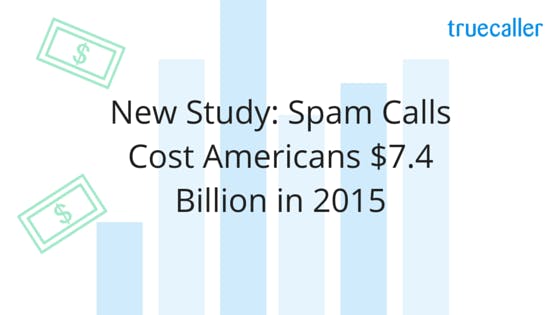
27M Americans Lost Approximately $7.4B in Phone Scams Last Year
Kim Fai Kok
Jan 22, 20164 min readEdited on Apr 24, 2018
We recently conducted our second annual study to find out how spam and unknown calls in the United States were affecting American bank accounts and emotions.

Two online surveys were conducted by Harris Poll in 2015 among U.S. adults age 18+, addressing the amount of money Americans lost through phone scams over 12 months, and the actions being taken following a scam or spam call or text to their phone.
Our results were astonishing.
Highlights from the report:
- Roughly 27 million Americans reported losing money to phone scams over the last 12 months, a 53% increase from 2014.
- Male millennials are the first ones to fall for scam more than women millennials. Around 38% of men reported to be fooled, and only 17% women.
- 64% of the adults surveyed admit they have not answered an unknown number
- Spam calls cost Americans .4 billion in 2015 – about 3.5 times the amount of advertising sales generated by the Super Bowl in last decade.
- Americans receive 15.8 spam calls (cell and/or landline) and 6.3 spam text messages in an average month.
The Breakdown
What once was commonly known that targeting cell phones was not allowed in the U.S., this is untrue in today’s mobile-first culture. Our research shows on average, Americans receive 3.95 calls per week from spam calls alone.
More than just a time drain and stress inducer, spam calls are changing the way Americans interact with their cell phones. More than 64% of the adults surveyed admit they have not answered an unknown number, and only 25% says they try and track down the number.
Of those who lost money to phone scams in the past 12 months, three quarters (74%) were scammed on a mobile phone, while one third (34%) were scammed on a home phone/landline.
What did Americans do after losing money to a scam?
- 39% signed up for the National Do Not Call Registry
- 34% changed phone number
- 32% used “reverse look-up” or searched phone number to try and identify caller
- 30% cancelled credit card or changed account numbers
- 27% signed up for credit protection/monitoring
- 25% contacted phone carrier
- 24% reported it to authorities (police, FCC, FTC)
- 21% checked phone bill
- 20% downloaded a spam blocker and 19% downloaded a caller ID app
- 9% did nothing
While almost half of the people signed up for the Do Not Call Registry, this still might not protect them from all spam calls, as we have warned about previously.
Spam calls come in a rainbow of categories, and are not always necessarily fraudulent. But they can still be annoying. With the Presidential Elections being a hot topic, and only 10 months away, political robocalls will start honing in to get donations and voters. We asked our participants how they felt about receiving such types of spam calls.
Spam calls/texts elicit a range of emotions
- Political robocalls or robotexts: Annoyance (56%); Frustration (26%); Enraged (15%); Afraid (2%); Helpless (6%)*
- Unknown number or anonymous user: Annoyance (52%); Frustration (26%); Enraged (15%); Afraid (11%); Helpless (7%)
- Live telemarketer: Annoyance (64%); Frustration (29%); Enraged (19%); Afraid (3%); Helpless (6%)
- Automated telemarketer/Robocaller: Annoyance (65%); Frustration (33%); Enraged (21%); Afraid (2%); Helpless (8%)
- Suspected Scammer or Fraudster: Annoyance (57%); Frustration (33%); Enraged (31%); Afraid (13%); Helpless (6%)
The Solution
We are encouraging Americans to use Truecaller’s suite of apps in a bid to eliminate spam calls. Not only can we help identify unknown numbers (whether it’s a colleague, the boss’s new number, a doctor, etc.). We offer our apps completely for free with no hidden costs. We want to make sure people have a way to be more knowledgeable about who is calling them, so they can decide to take the right call.
Survey Methodology
Two surveys were conducted online within the United States by Harris Poll on behalf of Truecaller via its Quick Query omnibus product in 2015. The first one was conducted November 12-16, 2015 among 2,023 adults aged 18 and older of which 134 have lost money in a phone scam in the past 12 months. The next was conducted from November 17-19, 2015 among 2,104 adults ages 18 and older.
The 2014 survey was conducted online within the United States by Harris Poll on behalf of Truecaller via its Quick Query omnibus product, from July 18-22, 2014 among 2,040 adults ages 18 and older, of which 135 have lost money in a phone scam in the past 12 months.
These online surveys are not based on a probability sample and therefore no estimate of theoretical sampling error can be calculated. For additional questions or complete survey methodology, please contact press@truecaller.com.

Kim Fai Kok
Jan 22, 20164 min read


